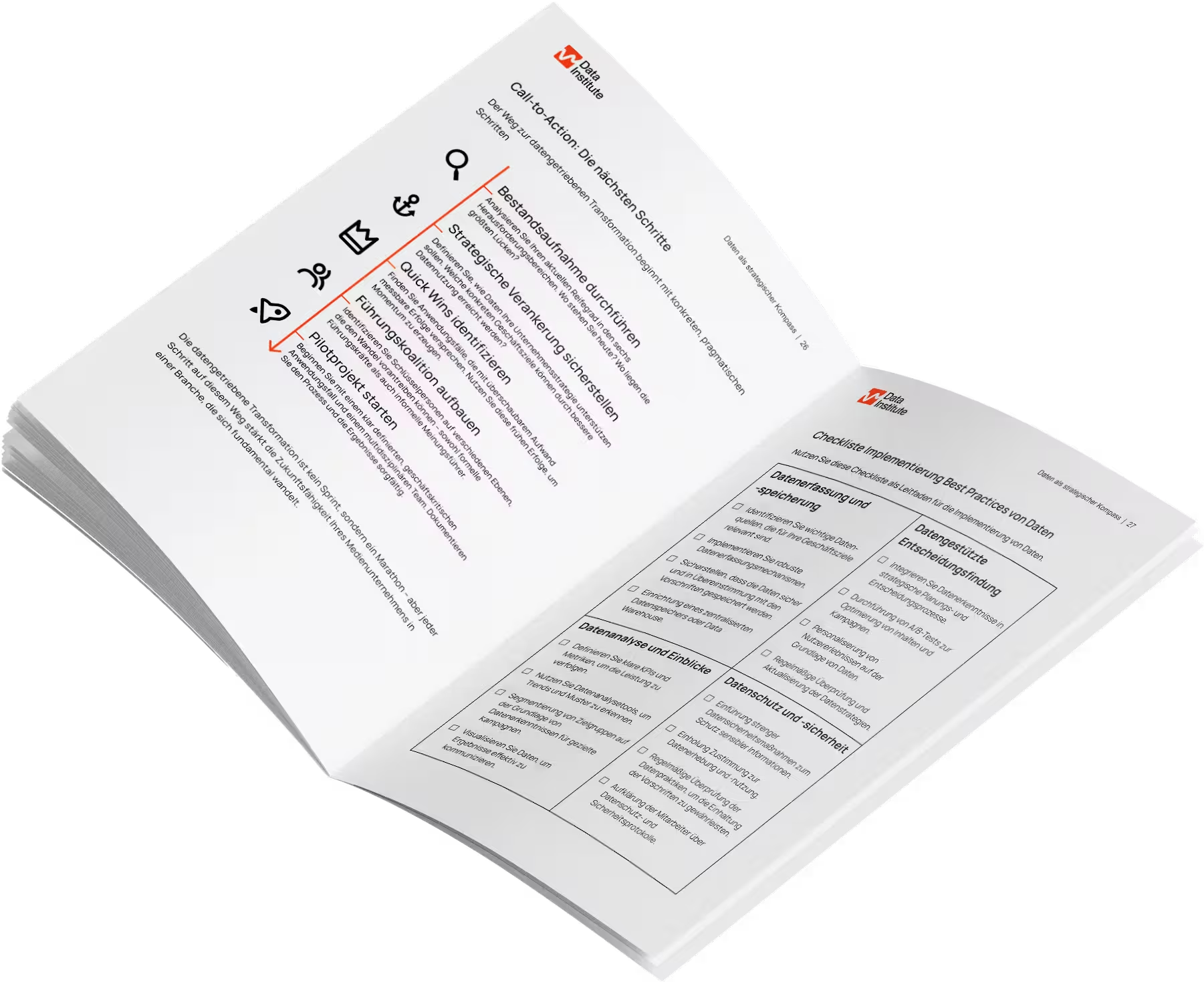All about data catalogs


The roadmap for data-driven transformation
The ePaper shows you strategies, success stories and a checklist for a direct start into the digital future.

- Das ist eine H2
- Das ist eine H3
What is a data catalog?
A data catalog (in German “Data Catalog”) is a directory, central repository or a database, which contains all data from a company. It is therefore the holy grail — all data that the company has ever collected or created is stored here.
The goal of the data catalog is to improve the findability, accessibility, and management of data within an organization. In return, users can search data more efficiently, discover new ones and use them, because in addition to the data itself, there is also metadata, descriptions for data sources, databases, tables, data sets, data source, and data quality noted. In addition, data catalogs can also contain information about data relationships, data lines, and data usage policies. They play a critical role in supporting data governance initiatives and promoting a data-driven corporate culture.
It also supports the view of data as assets.
What is a data catalog used for?
To become data-driven, companies must not only structure their data well, but also simplify access to it. This is exactly what a data catalog helps with. It thus optimizes data management and data usage in the company. In doing so, it also supports collaboration between teams.
A data catalog enables the following areas of application:
Data discovery
A data catalog enables users to quickly and efficiently find the data they need in large and complex data landscapes.
Data understanding support
By providing metadata and descriptions, the catalog helps users better understand the context, quality, and relevance of the data.
The basis for data governance
A data catalog supports Data governance initiatives by providing information about data ownership, data stewardship, data quality metrics, and data usage policies.
Fostering collaboration between teams and departments
Teams can comment on data sources add, share experiences, and share best practices, fostering collaboration between data scientists, data engineers, analysts, and other data users.
Security and compliance
The data catalog can help ensure that data is in accordance with data protection and Compliance-Organizational policies are used by providing information about data restrictions and permissions.
Data line (data lineage)
Some advanced data catalogs offer insights into the origin of the data, its movement through systems and its transformations, which is important for the data quality and integrity is crucial.
Self Service
A data catalog can facilitate self-service access to data by allowing users to data sources to explore and retrieve based on their permissions.
Optimizing data projects
Thanks to the central accessibility of data, data projects, whether in analysis, in reporting or in data science, be carried out more efficiently and precisely.
Who uses a data catalog in the company?
A data catalog can culture drive forward strongly within the company. With a tool with a user-friendly interface, it is possible that not only employees in the data team, but from all specialist areas are able to find data there, interpret it and work with it — even without database know-how.
The data catalog in the company should have these functions
Of course, the demands that companies place on a data catalog are extremely different. They depend on the maturity level of the company, but also on the people who want to use the data catalog, as well as on the goals that the organization has. The data catalog must go to data strategy fit!
Data Catalog Tools has these key features:
Automate data
A well-maintained data catalog supports automated processes as opposed to manual processes. When set up well, it organizes and manages itself as much as possible — this ensures high speed. Data is then automatically entered, enriched and categorized because links are established between the data sets.
Connectors — the connection to existing tools
A data catalog should not be another weight for data teams. It is therefore possible to record data sets — regardless of the type and source. Whether from business intelligence tools, SQL queries, data integration tools, visualization tools, or even CRM and business tools.
Search functions
Now all data has been collected — then you should be able to pick them out one by one! A powerful search function helps you to obtain the correct search results quickly and even when entering several parameters and then be able to filter them again.
Data Lineage
A data lineage function can be thought of as a family tree. It shows where the data comes from and how it is connected to each other — a lineage, so to speak. If there is inconsistent data, based on Data lineage feature Find out where the problem is. This feature is also important in terms of Data Governance.
Glossary — so everyone is on the same page
To ensure that all employees in the company have the same understanding of data, a glossary that explains abbreviations and terms is supported. As a result, the data can also be tagged with keywords. This feature is also recommended with regard to the GDPR.
Metadata management
To ensure that not only pure data is collected, but also further information about it is available, metadata must be collected, which enriches the data in the data catalog. This also ensures more accurate search results and increases the quality of data usage.
Which metadata is considered in a data catalog?
Metadata is stored in a data catalog — i.e. data that describes a database or provides the user with information about the database. This increases the discoverability, evaluation and understanding of data.
The main metadata in a data catalog is:
Business metadata
Business metadata describes the business value and relevance of data, including its compliance with regulations. They facilitate communication between data experts and business users. A data catalog should not only help collect and organize this metadata, but also provide tools to supplement it with additional information such as tags, ratings, and annotations. This makes it easier for users to find, use, and trust the data.
Process-related metadata
Process-related metadata describes the creation of a database and its access and change history. They provide information about who is authorized to use the data. This metadata provides insights into data history, its sources, and updates, which helps analysts assess its relevance. They are also useful for troubleshooting and can be analyzed to gain insights about software users and the quality of the service offered.
Technical metadata
Technical metadata describes the organization and presentation of data, including its structures such as tables and indexes. They inform the responsible data users about how to handle the data, for example whether adjustments are necessary for analyses or integrations.
Abolish silos — buy data catalog
A data catalog is an important step on the way to becoming a data-driven company.
It ensures that silos are abolished, self-service increases and thus also improves the culture that exists in the company with regard to data. It also provides a better overview of existing data, makes categorization easier and thus gives data teams the freedom not only to collect data, but also to use it to establish new business models and automations.
Is your Modern Data Stack ready for the next growth phase? We provide the technical clarity for cost-effective architecture.
The Data Institute is your partner for:
- Conducting a pragmatic 4-day Tech Audit (e.g., share case study)
- Selecting the optimal tools (Catalog, Warehouse, ETL/dbt)
- Creating a blueprint for a scalable, future-proof data infrastructure
Take Action: Schedule a Free Data Strategy Consultation
Or start your deep dive: To the Ultimate Guide: Your Roadmap for Data-Driven Success

Do you want to know more about buzzwords in data?
You can find news in our newsletter!
Do you want to know more about buzzwords in data?
You can find news in our newsletter!

Do you want to know more about buzzwords in data?
You can find news in our newsletter!

Related case studies
There are suitable case studies on this topic
Which services fit this topic?

Become a data-driven company?
Subscribe to our newsletter and stay up to date.
Become a data-driven company?
Subscribe to our newsletter and stay up to date.

Become a data-driven company?
Subscribe to our newsletter and stay up to date.







